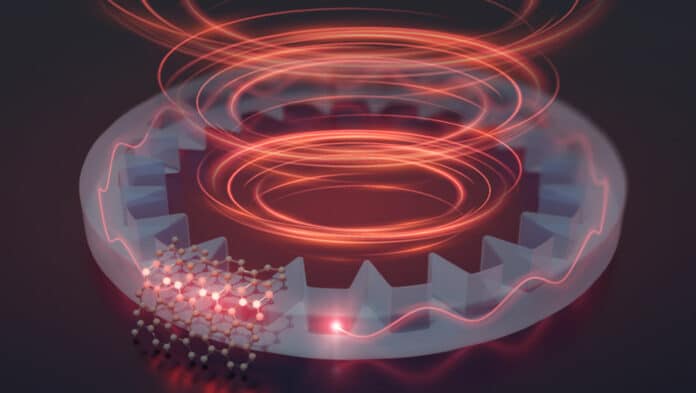Usually, information is “written” onto the spin angular momentum of a photon in quantum communication systems. In this scenario, photons either do a right- or left-circular rotation or combine to produce a two-dimensional qubit, a quantum superposition of the two. Information can also be stored on a photon’s orbital angular momentum, the corkscrew path light takes as it advances while each photon circles the beam’s center.
Qubits and qudits propagate information stored in photons from one point to another. The main difference is that qudits can carry much more information over the same distance than qubits, providing the foundation for turbocharging next-generation quantum communication.
In a new study, quantum scientists at Stevens Institute of Technology have demonstrated a method for encoding more information into a single photon, opening the door to even faster and more powerful quantum communication tools. They also show that they can create and control individual flying qudits, or “twisty” photons, on demand.
Yichen Ma, a graduate student in Strauf’s NanoPhotonics Lab, said, “Normally, the spin angular momentum and the orbital angular momentum are independent properties of a photon. Our device is the first to demonstrate simultaneous control of both properties via the controlled coupling between the two. It is a big deal that we’ve shown we can do this with single photons rather than classical light beams, which is the basic requirement for any quantum communication application.”
“Encoding information into orbital angular momentum radically increases the information that can be transmitted. Leveraging “twisty” photons could boost the bandwidth of quantum communication tools, enabling them to transmit data far more quickly.”
Scientists used an atom-thick film of tungsten diselenide to create twisty photons to create a quantum emitter capable of emitting single photons. Next, they coupled the quantum emitter in an internally reflective donut-shaped space called a ring resonator. By fine-tuning the arrangement of the emitter and the gear-shaped resonator, it’s possible to leverage the interaction between the photon’s spin and its orbital angular momentum to create individual “twisty” photons on demand.
The key to enabling this spin-momentum-locking functionality relies on the gear-shaped patterning of the ring resonator, which, when carefully engineered in the design, creates the twisty vortex beam of light that the device shoots out at the speed of light.
By integrating those capabilities into a single microchip measuring just 20 microns across — about a quarter of the width of a human hair — the team has created a twisty-photon emitter capable of interacting with other standardized components as part of a quantum communications system.
Ma said, “Some key challenges remain. While the team’s technology can control the direction in which a photon spiral — clockwise or anticlockwise — more work is needed to control the exact orbital angular momentum mode number. That critical capability will enable a theoretically infinite range of different values to be “written” into and later extracted from a single photon. The latest experiments in Strauf’s Nanophotonics Lab show promising results that this problem can soon be overcome.”
“Further work is also needed to create a device that can create twisted photons with rigorously consistent quantum properties, i.e., indistinguishable photons — a key requirement to enable the quantum internet. Such challenges affect everyone working in quantum photonics and could require breakthroughs in material science to solve.”
“Plenty of challenges lie ahead. But we’ve shown the potential for creating quantum light sources that are more versatile than anything previously possible.”
Journal Reference:
- Yichen Ma et al., On-chip spin-orbit locking of quantum emitters in 2D materials for chiral emission, Optica (2022). DOI: 10.1364/OPTICA.463481
